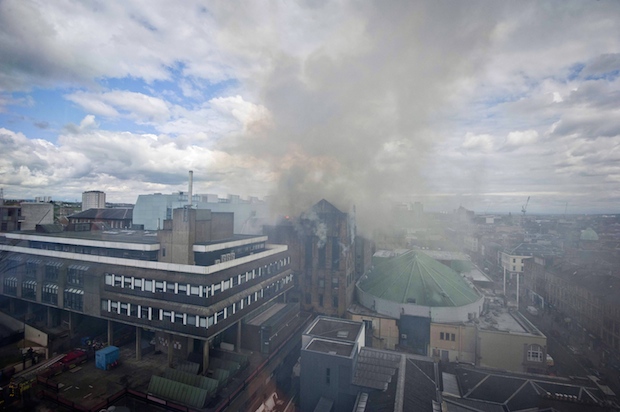It really is rotten luck, and also cruelly ironic. Just as Glasgow was done debating how best to demolish its hideous Red Road flats, its most beautiful building, Glasgow School of Art, goes up in smoke. No one hurt, apparently, which is a relief, but an awful lot of artwork lost, a unique archive and a precious library. However it’s the actual building which everyone seems most upset about. Indeed, I can’t recall a time when the destruction of a single structure made so many people so distressed. It shows we can love or hate a building, like a person. It shows architecture really matters. So why does Charles Rennie Mackintosh’s masterpiece matter so much?
Until you’ve seen Glasgow School of Art with your own eyes (not just on Google images) you can’t imagine its impact. It isn’t merely visual. It’s almost sensual. This building packs a punch. Mackintosh’s style is sometimes likened to Art Nouveau, but that comparison was never quite right and here it’s way off the mark. He has nothing in common with those effete Francophones. True, his interior designs are sometimes flowery, as in the Willow Tea Rooms, just up the road.
Here, however, he’s far more muscular. His Glasgow School of Art is more sculptural than architectural. It’s a futuristic fortress, a weird amalgam of ancient and modern. It feels as if it’s been there forever, yet over a century since it was built it still looks avant-garde. There really is nothing like it. The first time I saw it, I wasn’t even looking for it. I spotted it from the top deck of a bus and said out loud, ‘What the hell is that?’
Its effect is heightened by its workaday surroundings. There are some grand buildings on Renfrew Street, but also an awful lot of tat. It’s an ordinary shopping street, not an august boulevard, like Edinburgh’s George Street or Princes Street. Glasgow is mercantile, not regal. Unlike Edinburgh, it has no Royal Mile. This humdrum habitat is a reflection of Mackintosh’s life story. A student at Glasgow School of Art, he designed the new headquarters of his alma mater when he was still in his twenties.
However, despite a happy marriage, his subsequent career was stop-start, marred by depression and drink. Many of his greatest plans – for concert halls, railway stations, museums and cathedrals, were never realised. A heroic failure, he was respected in his lifetime, but relatively unsuccessful. Yet since his death, in 1928, aged 60, his reputation has blossomed. He’s become Scotland’s national architect and designer, a sort of Hibernian William Morris – a Scottish, not a British icon, even though he died in London, and is buried in Golders Green.
At a time when Scotland is asserting its cultural (and perhaps its political) independence, Glasgow School of Art has become a national monument – of Scotland, not Great Britain. For the first time in my lifetime, a Scottish news story feels like foreign, not domestic news. Englishmen are saddened, but they’re not distraught. They’re not weeping, like Muriel Gray. Whatever the outcome of the forthcoming referendum, this fire shows how much things have changed. The Scots are grieving the loss of their most iconic building, and though we’re very sorry, it’s a grief the English can’t really share.
William Cook also writes for the Independent and Conde Nast Traveller. His latest book is One Leg Too Few – The Adventures of Peter Cook & Dudley Moore.






Comments